Freedom Force Preview
Irrational's Ken Levine demonstrates an early build of this role-playing game to us.
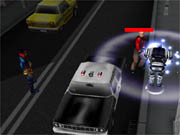
While they seem to have found a home on the console systems in the form of fighting games, comic book games haven't faired nearly as well in the PC market. In fact, the last comic book-related games brought to the PC were Acclaim's lackluster side-scrolling games--Judge Dredd, Ironman/X-O Manowar, and Batman Forever--which were generally shunned by both dedicated and casual comic book fans alike. As the string of horrible releases continued, comic book games became the bane of the industry, with publishers and developers ignoring comic book licenses and properties as if they were inflicted with the plague because there wasn't an audience for them. The outlook for comic book games seemed bleak for a number of years, but one developer decided to step in and not only end the comic book game draught but also put an end to the notorious comic book game curse. Irrational Entertainment, the developer behind System Shock 2, is currently hard at work on Freedom Force--a comic book-like tactical role-playing game that uses original characters and storylines but stays well within the realm of classic comics from the 1960s era when Stan Lee, Jack Kirby, and other comic book legends reigned supreme.
Even after coming to the decision to put its development resources behind a comic book-inspired game, the team at Irrational encountered a number of barriers it needed to overcome. "[Publishers we spoke to] thought people who read comics didn't play games," said Ken Levine, executive producer at Irrational Entertainment. Levine felt that publishers were rather unresponsive to the idea of a comic book game at that point, considering the subgenre's uninspiring history. But the development team was dedicated to finding a publisher that was more receptive to the idea and the potential a comic book game has when it's put in the hands of people who are truly fans. "Games are a natural place for the genre," Levine explained. "Every time you play a game, you're basically taking on the role of the superhero--with a small S." After approaching a number of publishers with the ideas that it wanted to incorporate into its game, Irrational finally found one willing to buck the trend and embrace the team's concept for the comic book game that would eventually become Freedom Force.
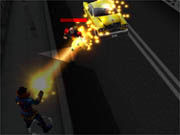
Take one look at Freedom Force, and you can see it's a comic book game like no other. Traditional comic book conventions, like the hero's ability to lift numerous large objects such as trucks or lampposts, are not only present in Freedom Force, but they also play a key role in determining the tactics you use during certain missions. The superheroes in Freedom Force all have unique personalities that play off each other and the enemies they encounter. But most importantly, in the traditional 1960s comic book style, no matter how powerful the superheroes may be, they all have a weakness that is exposed as you progress through the missions and begin to encounter different situations. We recently had a chance to sit down with Levine, and we took a look at many of Freedom Force's features and discussed what the team has in store for the final release of the game.
Superheroes Assemble
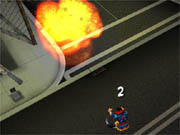
All of the major comic book companies like Marvel and DC Comics were built on the backs of a few key characters, and these characters are so dynamic that many of them still thrive today. Of course, Irrational could've taken the much easier route by purchasing a license and merely adapting the established characters to its game. But the developer knew that it would have to come up with its own characters to accomplish certain design goals--specifically a robust modification mode. The result is 14 original characters dispersed on the sides of good and evil, each with his or her own unique personalities, powers, and weaknesses. Like in most comics, perhaps the most interesting aspects of the characters are the stories of how they received their powers. In the game, these stories are presented in the traditional comic book style, where parts of the story are illustrated through panels.
Of all the characters in Freedom Force, Minute Man, the Captain America-like hero, seems to be a particular favorite of the Irrational development team. In keeping with the 1960s comic book spirit, the way Minute Man receives his powers is rather humorous, but at the same time, it describes the character quite well and gives him a deceiving amount of depth. One day, an old man and former member of the Manhattan Project hears one of his colleagues--whom he previously accused of being a communist sympathizer--speaking to a man with a thick Russian accent in the park. The old man is discovered and then attacked by the two suspicious figures, but before they can completely finish him off, the old man crawls toward a statue of a colonial minuteman that appears to be flashing. As he reaches for the statue, the old man is transformed into the character known as Minute Man, who wields the cane the old man once used to walk around the city. The other characters in Freedom Force have similar stories that set up their personalities. For example, Man Bot--the character with a full suit of armor--has the power to release tremendous amounts of energy, but he's unable to control it. After tragedy involving his powers, Man Bot dons the suit of armor to harness and control his powers until he finds a cure to rid himself of his unique abilities.
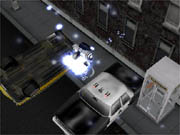
The process of writing the back stories for each of the characters isn't an easy task. Ken Levine quickly noted that the stories behind the characters in a typical role-playing game environment are a number of pages, but he was forced to compress each character's story into two pages so Irrational could adapt them to the traditional comic book-style introduction. Comic book fans should appreciate Freedom Force's character backgrounds because they are a prime example of Irrational's dedication to making Freedom Force feel like a 1960s comic. In those days, a character's background could be described in a few short sentences, but those few words gave valuable insight into the character and the type of world he or she was living in.
While the characters in Freedom Force undoubtedly feel like they came from a 1960s comic book, the gameplay is decidedly contemporary. Similar to the games in the X-COM series, Freedom Force actually mixes two different types of gameplay to deliver the superhero experience.
Able to Leap Tall Buildings
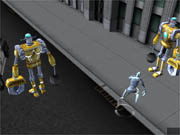
One possible reason comic book games haven't been successful, and possibly an explanation for the recent drought, is that many of them featured a relatively old style of gameplay, where the superhero character uses his or her powers to plow through wave after wave of enemy thugs until the final confrontation with a single villain character. This recipe worked well in the beginning, but it quickly wore out its welcome, and the lack of innovation in or deviation from that recipe eventually lead to the drought. Fortunately, Freedom Force not only makes the jump into a fully 3D world, but it also combines aspects of real-time strategy with gameplay elements from the recent AD&D role-playing games from Bioware. To put it more succinctly, you can select an action from a list before the hero actually performs it.
An early mission shown to us featured two superhero characters--El Diablo and Man Bot--who were pitted against a group of enemies in the middle of a street that was lined with lampposts and featured a massive truck parked at the north end. Levine first selected El Diablo and ordered him to throw a fireball by selecting the corresponding action on the pop-up menu screen. Next, Levine ordered Man Bot to walk over to the massive truck, where he had the option to lift the truck or use one of his default energy attacks. Selecting the former option, Levine ordered Man Bot to lift the truck and throw it toward the enemies. Levine then had El Diablo finish the rest of them off by picking up one of the lampposts and using it as a massive weapon. One problem with using objects in the scenery to attack enemies is that the pieces of the objects--whether it's a tire from the truck or the metal bar from the lamppost--actually break off, but the objects can be used over and over until they're completely destroyed. "It's not really a turn-based system," explained Levine. "It's more like the pause option from Baldur's Gate, where you can stop the game to select from all of the spells in the game." Regardless of how you view it, this style of gameplay adds a distinct strategic element, where small decisions can have a profound impact on the outcome of a battle. Expanding even further on the strategic element, some heroes are better for certain situations than others, and some superheroes actually work better as part of a team. But it's up to you to learn the strengths and weaknesses of the superheroes and select your team at the beginning of the mission accordingly.
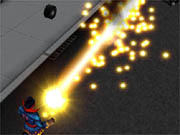
Another interesting feature in Freedom Force is its use of prestige points. Depending on how you perform in missions, your superhero receives a certain number of prestige points at the end, which you can use to improve different character attributes. In some cases, a superhero may learn new powers after he or she earns enough prestige points, but for the most part, the points only enhance the character's existing skills. It's also possible to lose prestige points that you've already earned, as the destruction of public property--like the complete demolition of surrounding buildings--or attacks on innocent bystanders are great ways to deprive the hero of points. Conversely, if the city and its inhabitants remain unscathed, then the prestige points should keep rolling in.
Final Thoughts
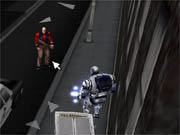
Understandably, a few gameplay elements weren't present in the build we were shown. The energy features, which weren't in the current build, play an important role in the game. Whenever characters attempt to lift an object or use a special attack, their energy is slightly depleted and they must wait for that portion of their energy to recharge before they can use it again. How much energy you use depends on both the superhero you're using and his or her current ability level, so while Man Bot may be able to lift a car with little or no problem, another character with little strength may not have such an easy time, thus using more energy resources.
Though the single-player mode is a major focus in Freedom Force, the customization options are going to be the main attraction of the game. Irrational is making sure that Freedom Force is as customizable as most modern first-person shooters, if not more so. Freedom Force includes a basic in-game character edit mode where you can edit a number of the preexisting characters' features, and it also lets you create entirely new characters and environments using primary resources like the scripting engine used by Irrational and secondary resources like 3D Studio Max and other 3D modeling utilities. You can make important characters die, turn them evil or good, and do just about anything else you can think of within the scope of the comic book universe. If you're so inclined, you can even re-create popular comic book characters and have them do battle within the Freedom Force universe--just picture an epic battle between Man Bot and Iron Man where the two throw massive bolts of energy at each other, causing massive amounts of damage to the buildings around them. Irrational hopes that the modification community embraces Freedom Force like it has the first-person shooter market, and with so many fans already clamoring to make their own creations, the development team shouldn't have any worries.
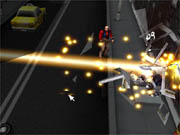
Fans craving multiplayer action won't be disappointed either, as Freedom Force features a number of different multiplayer modes. Along with regular deathmatch action, where characters battle each other with only their special powers, there are a few variants on the deathmatch theme. For example, one of the modes places you in the city with other players who can do as much damage to their area of the city as they want. Unfortunately, the development team isn't quite sure how many players Freedom Force's multiplayer mode will support.
Topping off all the features Freedom Force has to offer is a solid visual look that comes as close to looking like comic book art as possible without using the popular new cel-shading effect. The main character models are detailed, but they have soft features and basic color schemes that make them look as if they belong in the earliest comics, which used basic coloring and printing methods. There are also some nice special effects, such as liberal use of dynamic lighting whenever a character fires a projectile and reflective mapping on certain characters like The Bullet. A number of buildings with excellent architecture--especially the re-creation of the Empire State Building--populate the sides of the city streets, but overall, the environments look a little sparse in terms of finer details. Barring any unforeseen development delays, Irrational expects to finish and ship Freedom Force before the end of the year.
Got a news tip or want to contact us directly? Email news@gamespot.com
Join the conversation